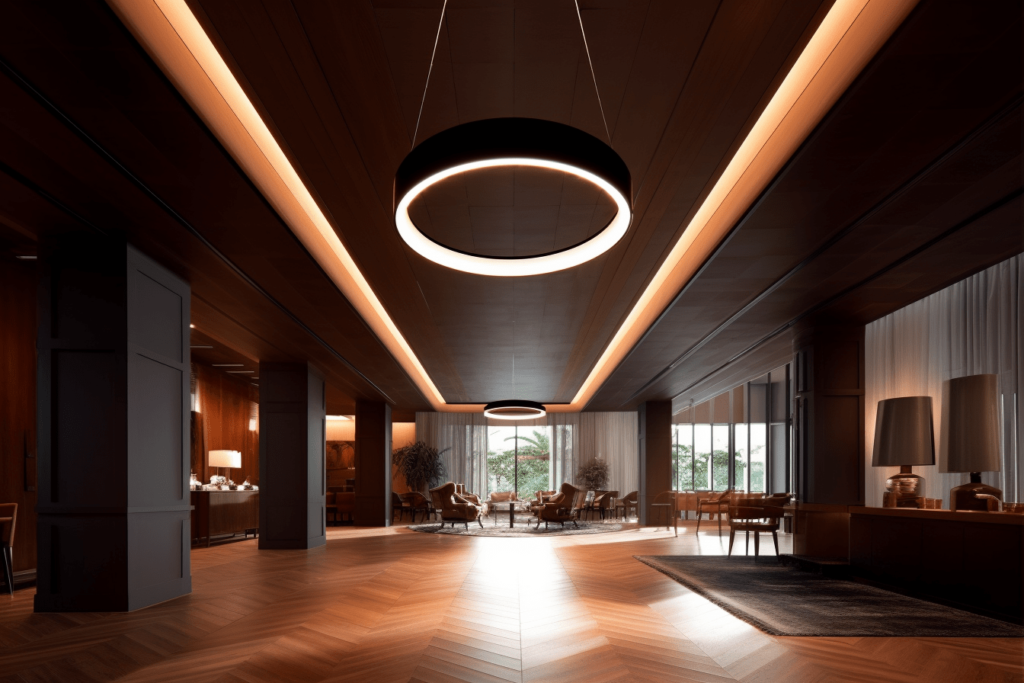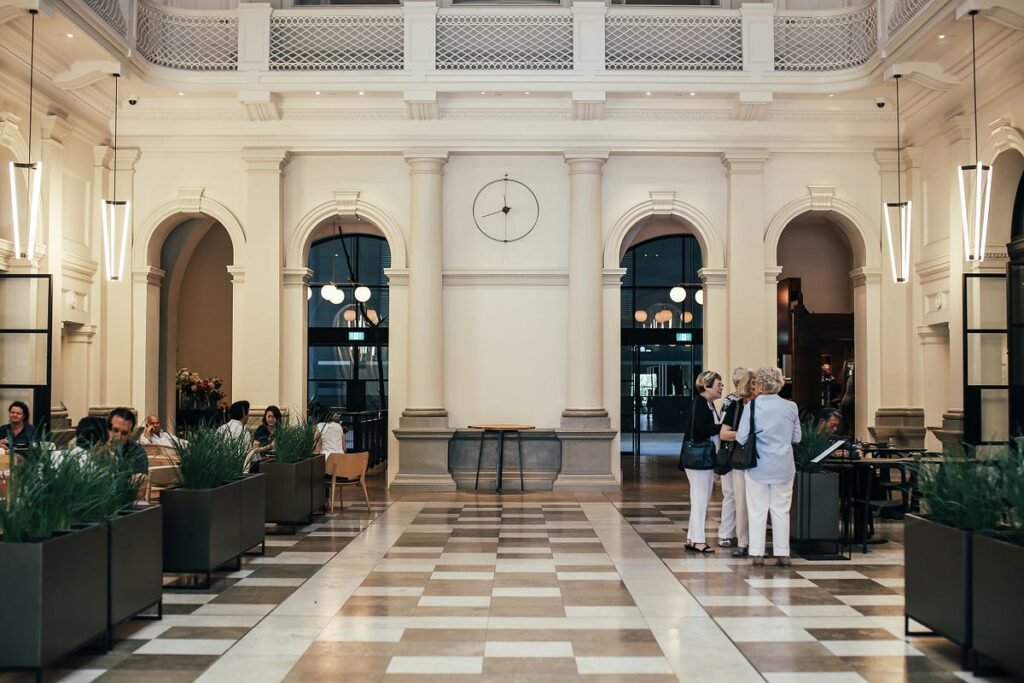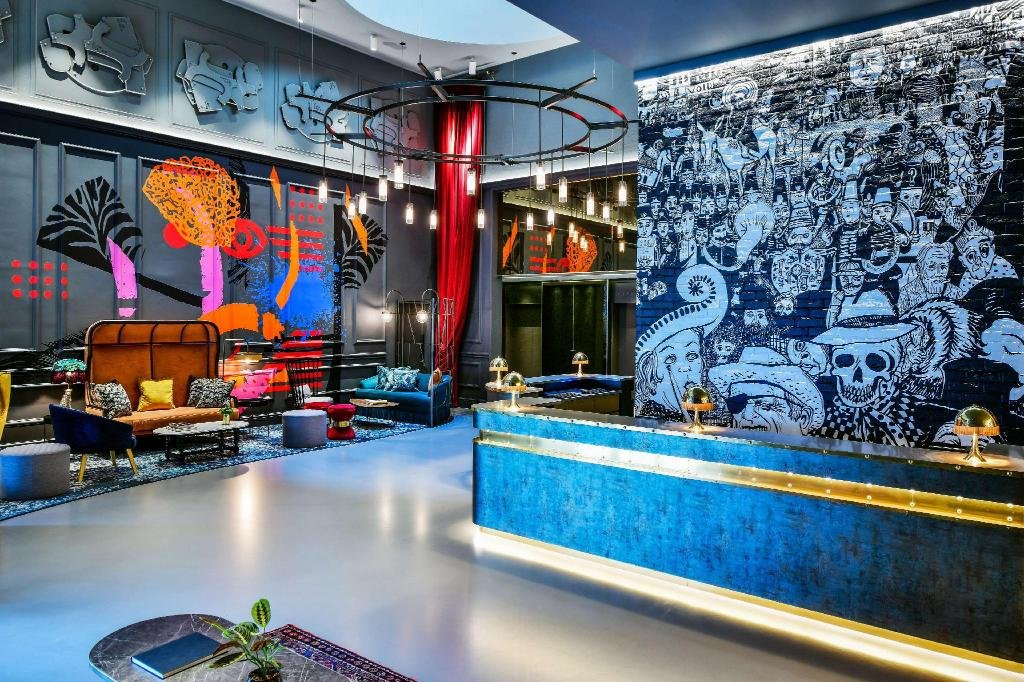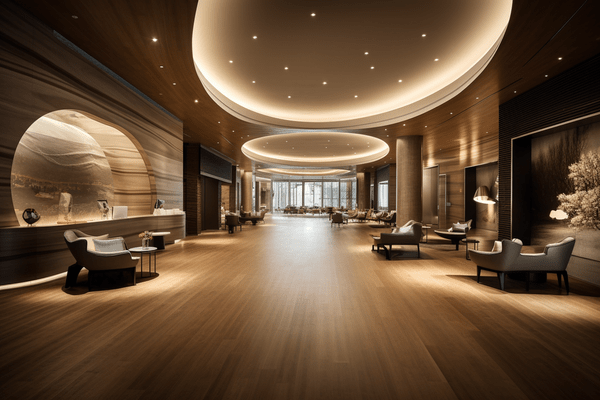Imagine walking into a hotel lobby and immediately feeling a sense of comfort and warmth. The secret lies in the carefully crafted lighting design that creates a welcoming ambiance. In this article, we will explore the key considerations in hospitality lighting design and how it can enhance the overall guest experience. From selecting the right fixtures to playing with lighting levels, join us on a journey of transforming spaces into inviting havens of relaxation and elegance.

Importance of Hospitality Lighting
Enhancing the Guest Experience
In the realm of hospitality, creating a warm and inviting atmosphere for guests is of utmost importance. Hospitality lighting plays a crucial role in enhancing the overall guest experience. The right lighting design can set the mood, create a sense of ambiance, and leave a lasting impression on guests. From the moment they step into a hotel lobby to the time they spend in their guest rooms, the quality of lighting can greatly impact how guests perceive their stay.
Setting the Mood and Atmosphere
One of the primary purposes of hospitality lighting is to establish the desired mood and atmosphere. The lighting design must be carefully considered to evoke the intended emotions. Whether it’s a soothing and relaxing atmosphere in a spa, a vibrant and energetic ambiance in a bar, or a cozy and intimate setting in a restaurant, the lighting should be tailored to create the desired atmosphere that matches the establishment’s brand and target clientele.
Highlighting Key Design Elements
Another important aspect of hospitality lighting is its ability to highlight key design elements within a space. Lighting fixtures can be strategically placed to draw attention to architectural features, artwork, or unique design elements. By properly illuminating these aspects, the lighting design can enhance the overall aesthetic appeal and create visual interest for guests.
Promoting Safety and Security
While aesthetics and ambiance play a significant role in hospitality lighting, safety and security should never be overlooked. Properly lit pathways, well-lit staircases, and clearly visible emergency exit signage are essential in ensuring the safety of guests and staff. Additionally, when guests feel secure in their surroundings, it contributes to their overall comfort and satisfaction during their stay.
Boosting Energy Efficiency
In an era of growing environmental consciousness, energy efficiency has become a key consideration in hospitality lighting design. By opting for energy-efficient lighting solutions, hotels and other hospitality establishments can significantly reduce their energy consumption and carbon footprint. LED lighting technology, lighting control systems, and motion sensors are just a few examples of energy-efficient solutions that can be incorporated into the design to optimize energy usage without compromising on the visual appeal or functionality of the space.
Understanding Lighting Basics
Types of Lighting
There are various types of lighting that can be used in hospitality settings, each serving its own purpose. Ambient lighting provides overall illumination and sets the general mood of a space. Task lighting is more focused and directed, providing ample illumination for specific tasks such as reading or working. Accent lighting is utilized to highlight specific areas or objects, adding depth and dimension to the overall design. Lastly, decorative lighting is purely aesthetic, creating a visually appealing focal point within a room.
Color Temperatures and Kelvin Scale
Color temperature plays a crucial role in the overall feel and ambiance of a space. The Kelvin scale is used to measure color temperature, ranging from warm to cool tones. Warm white light (around 2700K-3000K) creates a cozy and intimate atmosphere, while cool white light (around 5000K-6500K) provides a brighter and more energetic feel. Understanding the desired ambiance and purpose of each space is vital in determining the appropriate color temperature for hospitality lighting design.
Lighting Intensity and Brightness
The intensity and brightness of lighting can greatly influence the ambiance and functionality of a space. Different areas within a hospitality establishment may require varying levels of lighting intensity depending on their purpose. For example, guest rooms may benefit from adjustable lighting options to accommodate different preferences, while restaurants may require brighter lighting for clear visibility. Understanding the lighting needs of each space is essential in creating a comfortable and functional environment for guests.
Lighting Control Systems
Modern lighting control systems offer increased flexibility and convenience in managing different lighting elements within a hospitality setting. These systems allow for easy adjustment of lighting levels, color temperature, and even scheduling of lighting scenes to meet the specific requirements of a particular space. By integrating lighting control systems, hotels and other hospitality establishments can enhance the guest experience while maximizing energy efficiency and reducing operating costs.

Design Considerations
Overall Ambiance
When designing the lighting for a hospitality establishment, creating an overall ambiance that aligns with the brand and target clientele is crucial. The lighting should reflect the intended mood and atmosphere, whether it’s a tranquil and soothing space or a lively and vibrant environment. By carefully selecting the types of lighting, color temperature, and lighting intensity, designers can create a cohesive and immersive ambiance that leaves a lasting impression on guests.
Functional Lighting
While ambiance is important, functional lighting is equally essential in hospitality settings. Whether it’s providing sufficient lighting for guests to perform tasks in their rooms or ensuring clear visibility in common areas, functional lighting must be a priority. Properly lit pathways, well-illuminated countertops, and bright reading lights are just a few examples of functional lighting that should be incorporated into the design to enhance the overall guest experience.
Task Lighting
Task lighting is specifically aimed at providing focused illumination for specific activities. Incorporating task lighting in areas such as workstations, makeup vanities, and reading corners can greatly enhance functionality and guest comfort. By providing adequate and adjustable task lighting options, hotels and other hospitality establishments can cater to the individual needs of their guests, ensuring a comfortable and enjoyable stay.
Accent Lighting
Accent lighting serves as a means to highlight specific areas, objects, or architectural features within a space. By strategically placing accent lighting fixtures, designers can draw attention to key design elements and enhance visual interest. This can be particularly effective in showcasing artwork, sculptures, or unique architectural details, adding depth and character to the overall design.
Decorative Lighting
Decorative lighting is solely focused on aesthetics and serves as a centerpiece or focal point within a space. Chandeliers, pendant lights, or artistic light fixtures can add a touch of elegance and uniqueness to hospitality settings. The design and positioning of decorative lighting elements should align with the overall theme and style of the establishment, creating a visually stunning and memorable environment for guests.
Emergency Lighting
Emergency lighting is a critical aspect of hospitality lighting design. In the event of a power outage or emergency situation, emergency lighting ensures that guests and staff can safely navigate through the space and locate emergency exits. Combining functionality and aesthetics, emergency lighting fixtures should be strategically placed to provide ample illumination without compromising the overall design scheme.
Choosing the Right Fixtures
Consider the Space and Purpose
When selecting lighting fixtures for a hospitality establishment, careful consideration must be given to the specific space and its purpose. Different areas, such as lobbies, guest rooms, restaurants, or conference rooms, may require different types of lighting fixtures to effectively meet their respective needs. By understanding the unique requirements of each space, designers can choose fixtures that not only provide adequate illumination but also enhance the overall design and functionality.
Understanding Light Bulb Types
The choice of light bulbs significantly impacts the quality of light and energy efficiency. LED bulbs have gained popularity in hospitality lighting due to their longevity, energy efficiency, and versatility in color temperature options. Compact fluorescent lamps (CFLs) and halogen bulbs are also commonly used, each having its own advantages and considerations. Understanding the differences between these light bulb types and their impact on lighting design is critical in selecting the most suitable option for each space.
Optimal Mounting Heights
Proper installation and mounting heights are essential to ensure optimal lighting performance and visual comfort. The height at which fixtures are installed can significantly impact the distribution and coverage of light. For example, pendant lights above dining tables should be positioned at an appropriate height to avoid casting harsh shadows while still providing sufficient task lighting. By considering the intended purpose and desired lighting effect, designers can determine the optimal mounting heights for different areas within a hospitality establishment.
Consideration for Energy Efficiency
Energy efficiency is a significant concern in hospitality lighting due to the large-scale use of lighting fixtures in these establishments. By opting for energy-efficient fixtures, such as LED luminaires, hotels and other hospitality venues can significantly reduce their energy consumption and operating costs. Additionally, incorporating lighting control systems and motion sensors can further optimize energy usage by ensuring lights are only activated when needed.
Maintenance and Durability
Considering the maintenance and durability of lighting fixtures is crucial in hospitality settings where continuous operation is required. Selecting fixtures that are easy to clean, resistant to wear and tear, and have long lifespan can greatly reduce maintenance efforts and costs. It is also important to choose fixtures that can withstand the demands of high-traffic areas and maintain their visual appeal over time.

Using Lighting to Create Zones
Reception and Lobby Area
The reception and lobby areas are often the first points of contact for guests, and the lighting design should reflect the desired brand image and atmosphere. Soft and warm lighting can create a welcoming and inviting feel, while accent lighting can highlight key design elements such as artwork or architectural features. Depending on the space layout, a combination of ambient, accent, and decorative lighting can be utilized to create a visually stunning and memorable entrance for guests.
Restaurants and Dining Areas
Lighting plays a crucial role in creating the right ambiance and enhancing the dining experience in restaurants. Adjustable lighting options allow for different moods, from bright and energetic during breakfast service to dim and intimate during dinner. Pendant lights or chandeliers above dining tables can add a touch of elegance, while accent lighting can highlight featured artwork or displays. Using lighting to define different zones within the restaurant, such as the bar area or private dining spaces, can further enhance the overall dining experience.
Guest Rooms and Suites
Guest rooms and suites should be equipped with lighting that provides both functionality and comfort. Adjustable bedside reading lights, task lighting at work desks, and well-distributed ambient lighting all contribute to creating a comfortable and enjoyable living space for guests. Personalized lighting control systems in each room allow guests to adjust lighting levels to their preferences, further enhancing their overall experience.
Conference and Meeting Rooms
Conference and meeting rooms require versatile lighting options to accommodate various purposes, from presentations to collaborative work sessions. The lighting should provide ample illumination without causing glare or discomfort for participants. Lighting control systems with preset lighting scenes can be utilized to seamlessly adjust lighting levels to match the specific requirements of each activity. Additionally, accent lighting can be used to highlight presentation areas or enhance the overall aesthetic appeal of the space.
Spa and Fitness Facilities
Creating a tranquil and soothing ambiance is essential for spa and fitness facilities. Soft and warm lighting can evoke a sense of relaxation and tranquility, while adjustable lighting options in treatment rooms allow guests to personalize their experience. Incorporating natural elements, such as daylight simulations or artificial light that mimics natural light, can enhance the overall spa experience. In fitness facilities, bright and energizing lighting is necessary to promote alertness and visual comfort during workouts.
Integrating Natural and Artificial Lighting
Maximizing Natural Light
Incorporating natural light into hospitality environments can have significant benefits for both guests and the establishment. Natural light creates a sense of openness, enhances wellbeing, and provides a connection to the outdoors. Design considerations such as large windows, skylights, or lightwells can be implemented to maximize the entry of natural light into the space. By harnessing natural light, hotels and other hospitality venues can create a more inviting and refreshing environment for their guests.
Balancing Natural and Artificial Light
While natural light is desirable in hospitality spaces, it is important to strike a balance between natural and artificial lighting. Overreliance on natural light alone can result in uneven illumination levels throughout the day and potential glare issues. By strategically combining natural light with well-designed artificial lighting, designers can ensure consistent illumination, comfortable visual environments, and the ability to control lighting levels in response to changing natural light conditions.
Using Artificial Light to Complement Natural Light
Artificial lighting should be carefully designed to complement natural light and fill in the gaps where natural light may not reach or may not be available, such as during nighttime or in interior spaces with limited access to natural light. By using warm-tone artificial lighting to replicate the color temperature of natural light, a seamless transition between natural and artificial light sources can be achieved, enhancing the overall visual appeal and comfort of the space.
Applying Daylight Harvesting Techniques
Daylight harvesting techniques involve the use of sensors and lighting controls to automatically adjust artificial lighting levels based on the availability of natural light. This not only optimizes energy usage but also ensures consistent illumination levels throughout the day. By dimming or switching off artificial lights when sufficient natural light is available, hotels and other hospitality establishments can reduce energy consumption and create a more sustainable lighting system.

Sustainable and Energy-Efficient Lighting Practices
LED Lighting Technology
LED lighting technology has revolutionized the lighting industry with its energy efficiency, long lifespan, and versatility in color temperature options. LEDs consume significantly less energy than traditional incandescent or fluorescent bulbs, resulting in substantial energy savings for hospitality establishments. Additionally, the long lifespan of LEDs reduces maintenance costs and contributes to a more sustainable lighting solution.
Lighting Controls and Automation
Lighting control systems and automation allow for centralized management and scheduling of lighting operations in hospitality settings. By integrating motion sensors, occupancy sensors, and timers, lighting can be activated or adjusted automatically based on occupancy or specific time schedules. These systems ensure that lights are only in use when needed, further optimizing energy usage and reducing operating costs.
Motion Sensors and Occupancy Sensors
Motion sensors and occupancy sensors are invaluable tools for energy efficiency in hospitality lighting. By detecting the presence or movement of individuals in a space, these sensors automatically turn on or off lights as necessary. In areas with infrequent traffic, such as hallways or storage rooms, motion sensors can be particularly effective in eliminating unnecessary energy consumption.
Lighting Timers and Dimmers
Lighting timers and dimmers provide additional control over lighting levels and usage. Timers can be used to schedule lighting scenes or turn off lights during non-operational hours, preventing energy waste. Dimmers allow for adjustable lighting levels, providing flexibility to create different moods and reduce energy consumption when full brightness is unnecessary.
Sustainable Lighting Design
Sustainable lighting design involves a holistic approach to reduce energy consumption, minimize environmental impact, and enhance the overall guest experience. By combining energy-efficient lighting solutions, lighting controls, and sustainable design principles, hospitality establishments can create a more environmentally friendly and visually appealing lighting design. Moreover, sustainable lighting practices align with the growing demand for eco-friendly options, attracting environmentally conscious guests.
Addressing Safety and Security
Emergency Lighting Systems
Emergency lighting systems are critical in maintaining safety during power outages or emergency situations. These systems provide the necessary illumination to guide guests and staff to the nearest exits and evacuation routes. Incorporating backup power supplies and centrally monitored systems ensures that emergency lighting functions reliably, allowing for a safe evacuation and peace of mind for everyone in the hospitality establishment.
Emergency Exit Signage
Clear and visible emergency exit signage is essential for evacuating guests safely during an emergency. Well-placed exit signs with luminescent or illuminated features ensure that guests can easily identify the designated exit routes. By complying with safety regulations and guidelines for the placement and visibility of exit signs, hospitality establishments demonstrate their commitment to the safety and well-being of their guests.
Lighting for Evacuation Routes
Well-illuminated evacuation routes are crucial for guests and staff to navigate safely during an emergency. These routes should be adequately lit to provide clear visibility, and lighting fixtures should be positioned to avoid casting shadows or glare. Including emergency lighting systems along evacuation routes ensures that guests can easily identify and follow the designated paths, further enhancing safety and security.
Anti-Glare and Anti-Flicker Measures
Glare and flicker are common issues that can cause discomfort or visual impairment. In hospitality lighting, it is important to incorporate anti-glare measures, such as diffusers or light baffles, to minimize direct glare from lighting fixtures. Similarly, utilizing high-quality lighting fixtures with flicker-free technology ensures a comfortable and visually appealing environment for guests, free from distractions or discomfort.
Security Lighting
Security lighting is essential in hospitality settings to deter potential threats and provide a sense of safety for guests and staff. Well-lit parking lots, building exteriors, and pathways help prevent criminal activities and enhance surveillance efforts. By strategically placing security lighting fixtures and adopting intelligent lighting control systems, hotels and other hospitality establishments can create a secure environment for their guests without compromising aesthetics.

Considerations for Specific Hospitality Settings
Hotels and Resorts
In hotels and resorts, lighting design should create an inviting and comfortable environment for guests. The lobby and reception areas should have warm and welcoming lighting, while guest rooms require a combination of functional and ambient lighting. Outdoor lighting should consider pathways and landmarks to ensure safe navigation. Additionally, incorporating decorative and accent lighting in common areas like restaurants, bars, and poolside areas can enhance the overall guest experience.
Restaurants and Bars
Lighting plays a vital role in creating the right ambiance in restaurants and bars. Dimmable lighting options allow for flexibility, accommodating different moods and occasions. Warm lighting with accent features can create an intimate atmosphere, while brighter lighting may be desired in active bar areas. The lighting design should also consider practical aspects, such as providing adequate task lighting for staff and highlighting food and drink presentation.
Spas and Wellness Retreats
In spas and wellness retreats, lighting should promote relaxation, tranquility, and rejuvenation. Soft and warm lighting helps create a serene atmosphere, while adjustable lighting options allow guests to customize their experience. Incorporating natural elements, such as daylight simulations or light therapy, can further contribute to creating a calming and therapeutic ambiance.
Casinos and Entertainment Venues
Lighting in casinos and entertainment venues is often dynamic and vibrant. Carefully positioned accent lighting can highlight gaming areas or stages, while colorful LED lighting can create an energetic and lively atmosphere. The lighting design should focus on enhancing the visual appeal and excitement of the space, while also considering the functionality and safety of guests and staff.
Conference Centers
Conference centers require flexible lighting solutions that can adapt to various event requirements. Lighting control systems with preset scenes can be utilized to provide appropriate lighting levels for presentations, workshops, or networking events. The lighting design should also consider the visibility and comfort of participants, ensuring that lighting levels and color temperatures are suitable for different activities.
Collaboration with Lighting Design Professionals
Engaging Lighting Design Experts
Given the importance of lighting in hospitality environments, collaborating with experienced lighting design professionals is highly recommended. Lighting designers possess the expertise and knowledge to create an effective lighting design that meets the unique requirements of the establishment. They can provide valuable insights on lighting concepts, energy efficiency solutions, and design aesthetics, ensuring a well-executed lighting plan that enhances the overall guest experience.
Aligning Lighting Design with Brand Identity
A successful lighting design should align with the brand identity and image of the hospitality establishment. By working closely with lighting designers, hotels and other establishments can ensure that the lighting design reflects the desired atmosphere, style, and target clientele. Whether it’s a luxurious and elegant vibe, a contemporary and minimalist feel, or a playful and vibrant atmosphere, the lighting design should adequately represent the brand’s identity and leave a lasting impression on guests.
Considering Budget and Cost
Collaboration with lighting design professionals also involves considering budget constraints and cost-effectiveness. Lighting designers can guide establishments in selecting fixtures and technologies that offer the best value for the desired lighting design. They can help identify cost-effective solutions, prioritize lighting elements based on budget allocations, and propose alternatives without compromising on the overall design quality or guest experience.
Reviewing Lighting Design Proposals
Lighting designers will typically present lighting design proposals that outline the recommended lighting fixtures, layout, and design concepts. During the review process, hospitality establishments should carefully evaluate the proposals, ensuring that they meet the specific requirements and expectations. This is also an opportunity to provide feedback and discuss any necessary adjustments or revisions to the proposed lighting design.
Ensuring Compliance with Safety Regulations
Safety regulations play a crucial role in lighting design for hospitality settings. Lighting designers should ensure that the proposed lighting design complies with local safety regulations and codes. This includes considerations such as emergency lighting, proper mounting heights, exit signage visibility, and anti-glare measures. Collaboration with lighting design professionals helps ensure that the lighting design meets all necessary safety standards, providing a safe and secure environment for guests and staff.
By considering the importance of hospitality lighting and understanding the various factors that contribute to its successful design, hotels, resorts, restaurants, and other hospitality establishments can create visually stunning, functional, and energy-efficient environments that enhance the overall guest experience. Collaboration with lighting design professionals and adherence to safety regulations further contribute to the success of the lighting design, ensuring a welcoming and memorable experience for every guest.


